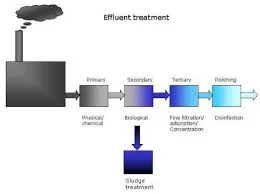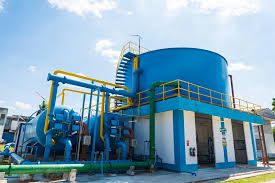Industrial wastewater treatment refers to the procedures used to treat wastewater produced as an unwanted byproduct by industries. After treatment, the industrial wastewater (or effluent) may be recycled, released into a sanitary sewer, or dumped into a body of water. Wastewater produced by some industrial facilities can be treated in sewage treatment plants.
The majority of industrial processes, including chemical and petrochemical plants, refineries, and chemical and petroleum plants, have their own specialized facilities to treat their wastewaters so that the pollutant concentrations in the treated wastewater comply with the rules regarding disposal of wastewaters into sewers or into rivers, lakes, or oceans.
This is relevant for enterprises that produce wastewater with high levels of organic matter (like oil and grease), hazardous contaminants (such heavy metals, volatile organic compounds), or nutrients like ammonia.
A pre-treatment system may be installed by some industries to remove some pollutants (such as hazardous chemicals), and the partially treated wastewater may subsequently be discharged into the municipal sewage system.
Wastewater is produced by most industries. Minimizing such production or reusing treated wastewater in the manufacturing process have been recent trends. Some firms have had success changing their production procedures to cut back on or completely get rid of pollution.
Manufacturing of batteries, chemicals, electric power plants, food, iron and steel, metal working, mines, quarries, nuclear power, oil and gas extraction, petroleum refining, and petrochemicals, pharmaceutical manufacturing, pulp and paper industry, smelters, textile mills, industrial oil contamination, water treatment, and wood preservation are some industries that produce industrial wastewater.
Brine treatment, the removal of solids (e.g., chemical precipitation, filtering), the removal of oils and grease, the removal of other organic compounds, the removal of biodegradable organics, the removal of acids and alkalis, and the removal of poisonous substances are some of the treatment procedures.
The following industrial wastewater flows may be produced by industrial facilities:
▪ Waste streams from manufacturing processes, which might include detrimental nutrients, toxic pollutants including solvents and heavy metals, and conventional pollutants that can be controlled by secondary treatment systems
▪ Boiler blow down and cooling water, which produce thermal pollution and other pollutants, are examples of non-process waste streams.

▪ Industrial site drainage produced by mining and energy sites as well as manufacturing and service sectors
▪ Radionuclides, generated water from oil and gas extraction, and acid mine drainage are examples of waste streams from the energy and mining industries.
▪ By-products of treatment or cooling processes include brine and backwashing (water treatment).
In order to create an effluent that is suitable for release to the environment or a planned reuse application, sewage treatment, also known as domestic wastewater treatment or municipal wastewater treatment, removes contaminants from sewage.
This reduces the risk of water pollution from sewage discharges. Sewage includes pre-treated industrial effluent as well as wastewater from homes, companies, and possibly other sources.
There are many different options for sewage treatment. These can range from small, centralized systems with a network of pipelines and pump stations (known as sewerage) that transport the sewage to a treatment facility to big, decentralized systems with on-site treatment systems. Urban runoff (storm water) will be transported to the sewage treatment facility by the combined sewers in cities with this system.
Read Also : Hazardous Waste Disposal Near Me
While sophisticated sewage treatment also includes a tertiary treatment stage with polishing procedures and nutrient removal, sewage treatment frequently entails two basic phases known as primary and secondary treatment.
With the help of aerobic or anaerobic biological processes, secondary treatment can lower the amount of organic matter (expressed as biological oxygen demand) in sewage.
The following are the four primary chemical classes utilized in wastewater treatment:
▪ Neutralizers for pH
▪ Anti-foaming substances
▪ Coagulation aids
▪ Flocculants.
pH neutralizers are the simplest simple class of chemicals, albeit their uses and benefits depend on the process that generates the wastewater.
Anti-foaming agents make up the next group of compounds used in wastewater treatment. Foam may be very problematic for a variety of industrial operations because it results from the production of air bubbles in wastewater.
Coagulants and flocculants, the final two primary types of water treatment chemicals, combine to clear wastewater and remove suspended solids. Coagulants are low molecular weight, ionically charged substances that are typically positively charged and are used to balance the charge of suspended particles.
They can be organic polymers or inorganic compounds made of aluminum or iron that work against the “repulsive” action that prevents negatively charged particles from aggregating.
The wastewater treatment process is divided into three basic stages that are accurately referred to as primary, secondary, and tertiary water treatment. Quaternary water treatment, which is more sophisticated, is necessary in some applications.
Parts per million to part per billion contamination levels are dealt with at this stage, which frequently entails oxidation or fine filtration procedures. As the water progresses through these stages, it becomes cleaner while tackling various impurities.
In a settling tank, which is used during primary treatment, heavier sediments sink to the bottom while lighter solids float to the top.
These solids are kept back once they have settled while the liquid is drained or continues on to the more demanding secondary stage of wastewater treatment.
Secondary wastewater treatment is more thorough than primary treatment and is intended to significantly reduce the biological component of the waste through aerobic biological processes.
By bringing common biodegradable contaminants down to safe levels, secondary wastewater treatment enables a safer release into the local ecosystem.
Tertiary wastewater treatment’s primary goals are to meet particular standards for safe water release or to improve the water’s quality to meet domestic and industrial standards. Municipalities use tertiary treatment to ensure that the water is safe to drink by also removing germs from the water.
In essence, sewage management is the process through which waste is handled for human benefit. Sewage treatment involves several procedures, including sewage treatment, sewage screening, and sewage treatment.
This also entails getting rid of the sewage in a way that doesn’t endanger or hurt the environment or people’s health. You will learn a little bit about sewage management in this post, along with the reasons why it is required.

